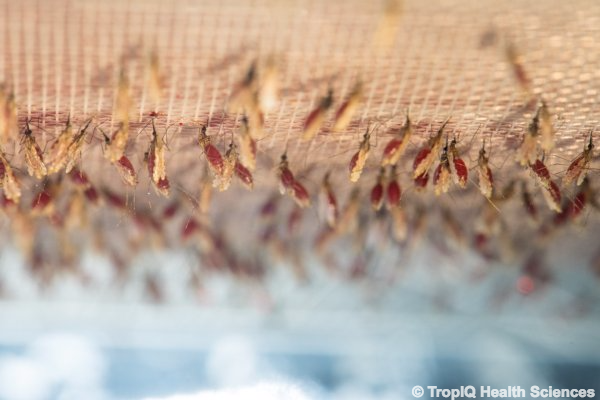Description
Material provided: Analysis of screening results, identification of hit-substances
Unit definition: up to 500 substances tested
Vector information
Family: Culicidae
Genus: Anopheles
Species: Anopheles stephensi
Strain: Sind-Kasur Nijmegen
Place of origin: Pakistan
Date of colonization: 1982
Parasite information (if applicable)
Phylum: Apicomplexa
Genus: Plasmodium
Species: Plasmodium falciparum
Strain: NF54-ΔPf47-5’hsp70-GFP-Luc (Short: NF54-HGL) expressing a GFP-Luciferase fusion protein under the control of the Pfhsp70 promoter, genomic integration, no selection marker.
Infectivity: Infectivity tested and quantified
Mycoplasmic contents: Mycoplasma free
Product description
Up to 500 different feeding conditions can be tested using antibodies, compounds, small molecules or different concentrations of particular substances of interest. For insecticide tests, substances are added to the blood meals and fed to Anopheles stephensi mosquitoes in 96 well plates. For transmission-blocking activity, test substances can be added directly to blood meals containing stage V gametocytes, or gametocytes can be pre-incubated for 24h prior to feeding.
The technique combines three main steps:
- Feeding : 48 Substances are fed to 600 mosquitoes simultaneously using a 96 well plate format. This will be repeated until all substances requested have been tested. Every substance is combined with a DNA barcode that will stay inside mosquitoes after feeding.
- Phenotypical Readout : The test substance decides over the type of phenotypical feature used for the readout (see product options for more details). All DNA barcodes present inside mosquitoes are detected using a multiplexing technology.
- Analysis : The results of the multiplexing identifies active test substances.
Product options
The technique can be adapted according to the users application.
The options include, but are not limited to:
- Screening for systemic insecticides : Here every screening substances will be mixed with an individual DNA barcode and fed to mosquitoes in a 96 well plate. Usually after 24h dead and alive mosquitoes will be collected and their DNA barcodes determined to identify active substances.
- Screening for transmission blocking substances: Here every screening substance will be mixed with an individual DNA barcode and Plasmodium falciparum (NF54-HGL) stage V gametocytes. Eight days after feeding, a luciferase assay is performed on every mosquito and infected and uninfected mosquitoes are determined. The DNA barcodes of these mosquitoes identifies active substances.
For more information, please contact us.

